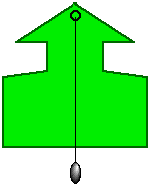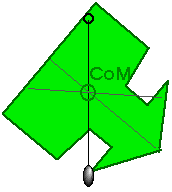

Center of Mass
When calculating the torque (or rotational force) caused by the weight of an object, the object may be treated as a rigid, massless shell with all its mass or weight concentrated at the center of mass. For a regular, uniform object, this center of mass or center of gravity is located at the ordinary center of the object.
The Center of Mass has been described as "a uniquely interesting point". It is interesting for motion as well as for equilibrium situations.
When we throw a baseball, we expect it to follow a smooth, parabolic trajectory as we have discussed with projectile motion.
When we throw a baseball bat, however, its path or trajector does not seem smooth at all. While the bat rotates around the center of mass, the center of mass itself is following the same smooth, parabolic path that we expect for a smaller, simpler object, like a baseball.
The center of mass itself follows the same smooth path that we expect for a smaller, simpler object, like a "point particle".

How can we locate the Center of Mass in an extended object?We can suspend it. The Center of Mass will always be directly under the point of support.
Then we can suspend it from some other point and know that the Center of Mass will always be directly under this point of support as well.



Remember that we can think of any object as a rigid, massless shell with all its mass concentrated at the Center of Mass.For a "compound object", the Center of Mass is, indeed, the average position of the mass and we can calculate its position by


When we talk of astronomical objects -- certainly galaxies, but even our own Earth and moon -- there is a difference.